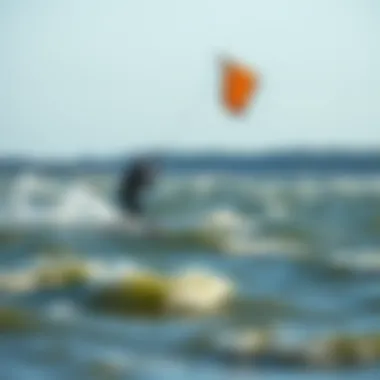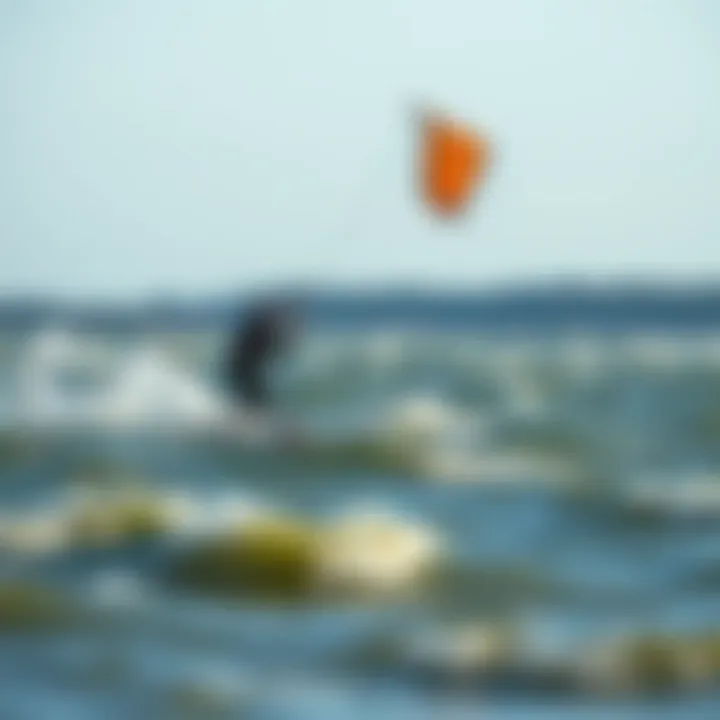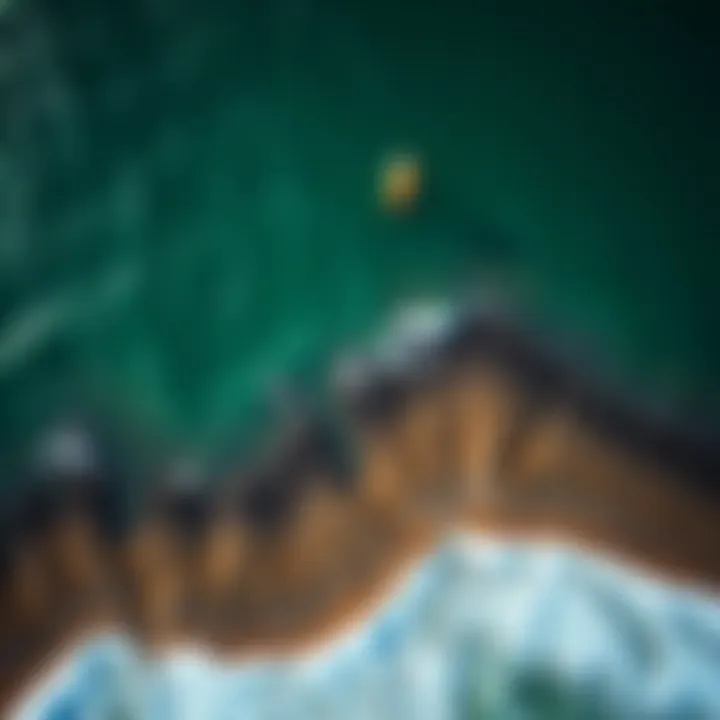Understanding Falmouth Tides for Kiteboarders


Intro
Kiteboarding in Falmouth is not just about the thrill of flying across the waves; it's also about understanding the tides that shape this exciting experience. For kiteboarders, tidal patterns can make the difference between a perfect ride and battling tricky water conditions. This piece aims to provide a comprehensive guide on the tides of Falmouth, helping enthusiasts not only to ride safely but also to maximize their enjoyment on the water.
The tidal rhythm in Falmouth is unique, influenced by various factors such as lunar phases, wind flow, and local geography. Understanding these elements can aid kiteboarders in selecting the best times for their sessions, ensuring both safety and an exhilarating experience.
With that in mind, let’s dive into the necessary gear and techniques that every kiteboarder should consider.
Equipment Insights
Latest Gear Reviews
When it comes to kiteboarding, having the right gear can significantly elevate your ride. Dealers in Falmouth often stock the latest in kite technology, and keeping an eye on new arrivals can be beneficial. Some products worth noting include:
- Duotone Rebels: Known for their performance across various wind conditions, these kites are versatile and reliable.
- Naish Pivot: Offers smooth transitions and incredible lift, making it a favorite among many riders.
- Ozone Enduro: Perfect for those who enjoy both freestyle and wave sessions, this kite has a great balance and control.
Researching gear reviews on platforms like reddit.com can also provide first-hand accounts from fellow kiteboarders. Many enthusiasts share their experiences and recommendations, helping others make informed decisions.
Essential Gear Maintenance
The longevity and efficiency of your kiteboarding gear largely depend on how well you maintain it. Here are a few tips to keep your equipment in top shape:
- Regular Inspection: Check for any signs of wear and tear, especially on the seams and fabric.
- Cleaning After Use: Rinse saltwater on your kite and bar to prevent corrosion. It’s a simple step that can make a world of difference.
- Storage: Keep your gear in a dry, cool place to prevent any damage from moisture or heat.
Proper maintenance not only prolongs the life of your equipment but also ensures you are safe while riding. It’s time well spent that pays off during your kiteboarding sessions.
"A well-maintained kite can be the difference between a great session and a dangerous one. Always check your gear."
– Professional Kiteboarder
Technique Exploration
Beginner Techniques
For those just starting their kiteboarding journey, familiarity with the tides can be daunting. When learning, it’s crucial to start during low tide, as the flat water offers a more forgiving environment. Key techniques include:
- Body Dragging: A fundamental skill that helps you understand how the kite pulls you through the water.
- Water Starts: Get comfortable with getting back on the board quickly, which is essential for riding in varying tide conditions.
Advanced Maneuvers
Once you’ve got the basics down, it’s time to push your limits. Understanding tidal movements here can open up more advanced maneuvers such as jumps and tricks. Here are a couple of advanced moves to consider:
- Kiteloops: Requires a bit of practice, but when executed well, they can be a spectacular addition to your riding.
- Backrolls and Frontrolls: These rotations can help you stand out among your peers and add to your repertoire.
Always keep in mind the special conditions that the tide creates, such as currents that can assist your jumps or affect landing.
Engaging with the local kiteboarding community can further enhance your skills and understanding of the unique Falmouth tides.
Preface to Falmouth Tides
Understanding the tides in Falmouth serves as a stepping stone for kiteboarders eager to navigate this vibrant location. Kiteboarding is as much about the thrill of riding the wind as it is about the nuances of the water beneath you. The interplay of the tides can significantly alter the conditions of the water, affecting everything from wave height to current strength. This article aims to deepen the comprehension of these tidal dynamics, ensuring kiteboarders make informed choices for their sessions.
The significance of grasping Falmouth’s tidal patterns extends beyond mere enjoyment; it envelops safety, skill development, and effective planning. Those who familiarize themselves with the local tides can not only optimize their ride times but also become more resilient in the face of changing conditions. The connection between tidal knowledge and superior kiteboarding experiences is undeniable.
Geographical Context
Falmouth, nestled on the southwestern coast of England, boasts a unique coastal geography that influences its tides. The town is flanked by expansive beaches and rugged cliffs, creating a distinguishable atmosphere for water sports enthusiasts. With the presence of natural harbors, the tidal range here can be profound, making it a notable spot for kiteboarding.
The area’s proximity to the mighty Atlantic Ocean means the tides are influenced by both lunar cycles and prevailing weather patterns. In fact, the surrounding geography arms kiteboarders with varied riding environments, from serene flat waters ideal for beginners to choppy waves that challenge the most experienced riders. Knowing where to find the right conditions, depending on tide levels, is critical to making the most of your time on the water.
Significance for Kiteboarding


For kiteboarders, the tides are not just background noise; they are the very canvas upon which they paint their adventure. Understanding whether the tide is ebbing or flowing can dictate the style of riding one chooses to undertake. This awareness can lead to an enhanced experience, as different tides provide different opportunities.
When the tide is high, riders might encounter exhilarating conditions, such as gentler waves and smooth water, which can be perfect for tricks or leisurely sessions. Conversely, low tide can expose new sandy areas and create strong currents that skilled boarders often relish, pushing their limits.
"Whether you’re a novice or an aficionado, recognizing how the tides affect conditions can make the difference between a memorable ride and a difficult struggle."
In practical terms, savvy kiteboarders would benefit immensely from consulting local tidal charts and predictions. By aligning riding sessions with optimal tide conditions, they can reduce risks associated with strong currents and unpredictable wave patterns. This foresight not only enhances individual performances but also contributes to a more enjoyable experience overall.
Understanding Tidal Dynamics
Understanding tidal dynamics is crucial for kiteboarders seeking to make the most of their time on the water in Falmouth. The interplay of lunar cycles and gravitational forces creates a rhythm to the tides, which in turn impacts water conditions, currents, and general safety. Kiteboarding is all about riding the waves efficiently and safely; thus, grasping how tides move and shift can mean the difference between a fun session and a difficult one.
Tidal Forces Explained
The essence of tidal forces lies in the gravitational pull exerted by the moon and the sun. While it might seem like a simple phenomenon at first glance, the mechanics behind it reveal much complexity. The moon’s gravitational effect causes the water to bulge, creating high tides in locations directly beneath it. At the same time, on the opposite side of the Earth, another bulge occurs due to the centrifugal force formed by Earth's rotation. These changes in water levels are not just fascinating; they also dictate when things are best for kiteboarding.
Key Takeaways:
- Tides can rise and fall between 3 to 4 meters or more in Falmouth, depending on the lunar phase.
- Understanding peak times for high tide and low tide can help kiteboarders plan sessions effectively.
Types of Tides
When discussing tides, it’s important to differentiate between spring tides and neap tides as they have distinct characteristics affecting the kiteboarding experience.
Spring Tides
Spring tides occur during the full moon and new moon phases, when the sun and moon align, creating a formidable gravitational pull. This results in the highest high tides and the lowest low tides. For kiteboarders, spring tides provide optimal conditions: the stronger currents can enhance the ride, giving an opportunity to try stunts or speed runs.
Characteristics of Spring Tides:
- More pronounced elevation of tides
- Increased current strength
Riding at this time can feel incredibly invigorating, but cautious kiteboarders should also be wary of potential hazards such as rapidly shifting water and strong currents.
Neap Tides
Neap tides occur during the first and third quarters of the lunar cycle, when the sun and moon are at right angles relative to Earth. This results in lower high tides and higher low tides. While kiteboarders may find the ride less intense, this is often a blessing in disguise. These calm waters can offer a more laid-back experience, ideal for beginners or those looking to practice maneuvers without the added pressure of strong currents.
Characteristics of Neap Tides:
- Milder water conditions
- Reduced current strength
"The mastery of tides is key to unlocking the full potential of kiteboarding; timing is where skill meets opportunity."
For further insights on tidal patterns, you might check out resources like Wikipedia's Tides entry or Britannica's explanation of tides.
Falmouth Tidal Schedule
Understanding the tidal schedule in Falmouth is fundamental for kiteboarders, as it helps them make informed decisions about when to hit the water. The tides can bring about varying conditions that directly affect the quality of rides. Getting a grasp on the tidal schedule not only maximizes enjoyment but also enhances safety during kiteboarding sessions.
Current Tidal Charts
Current tidal charts serve as the go-to resources for kiteboarders looking to navigate the tidal fluctuations in Falmouth. These charts provide real-time data, illustrating the rise and fall of the water levels throughout the day.
The charts typically include:
- High Tide Times: Critical to know when the water is at its peak for optimal riding.
- Low Tide Periods: Understanding when the tide recedes aids in planning, as certain spots may become shallow or even challenging to access.
- Tide Heights: Knowing the specific height of the tide helps assess water conditions like waves and currents.
Checking these charts regularly can make a world of difference. Luckily, resources like NOAA Tides & Currents or local sailing clubs often publish current tidal data specific for Falmouth.
"Understanding the tidal patterns and times enhances your kiteboarding experience, leading to safer and more enjoyable rides." – Local Kiteboarding Expert


Predicting Future Tides
Predicting future tides can feel daunting, but it becomes easier with practice and by using available tools. Kiteboarders should familiarize themselves with tide tables or apps that allow for both short-term and long-term tidal predictions.
When studying tidal predictions, consider:
- Spring and Neap Tides: Knowing when these occur (typically two times a month) can help you anticipate stronger or weaker tidal effects, which can dramatically change riding conditions.
- Moon Phases: The moon plays an essential role in tidal patterns. Full moons and new moons usually indicate higher tides, which can offer prime conditions for certain kiteboarding spots.
- Wind and Weather Influences: Observing upcoming weather forecasts can help anticipate how wind patterns might affect tidal behavior, creating either ideal or tricky riding conditions.
For an accurate forecast, websites like Tide-Forecast or similar platforms can be invaluable, providing not just tide predictions but also charts that help visualize changes.
Understanding these tidal elements, whether current or future, ensures kiteboarders are always riding the waves with confidence. As the tides ebb and flow, so too should your adaptability and planning.
Impact of Tides on Kiteboarding
Kiteboarding in Falmouth is not just about the wind, though that plays a significant role. The tides here carry a weighty influence over the entire experience. Understanding the impact of tides is crucial for anyone looking to maximize their time on the water, as these tides dictate water conditions, safety measures, and overall enjoyment. Kiteboarders must learn to read and anticipate these fluctuations. This knowledge is not merely academic; it enhances the potential for an exhilarating ride while mitigating risks associated with changing conditions.
Influence on Water Conditions
The water conditions in Falmouth can shift dramatically based on the tide schedule. When the tide is high, you might notice a certain buoyancy to the water, almost like surfing in cream. The waves can be softer, making it an ideal time for learners and those wanting a leisurely session. Conversely, as the tide goes out, the water can become choppy, leading to a more rugged experience that seasoned kiteboarders might relish. When the tide is falling, it can create fun little wavelets, sometimes seen as small bumps for jumping or spinning.
- High Tide: Water levels are elevated, leading to smoother conditions. Beginners may find this time easier for practice.
- Low Tide: The water recedes, exposing sandbars and creating choppy conditions. Advanced kiteboarders often take advantage of this for tricks and jumps.
Understanding when to expect these conditions is a game changer. Checking local tidal forecasts is akin to having a cheat sheet. By coordinating your sessions with the tidal schedule, you optimize the level of challenge and fun. A high tide might inspire a chill day, while a low tide could ignite that competition spark.
Safety Considerations
With exciting challenges come risks. Kiteboarders must prioritize safety whenever they’re treading the waters of Falmouth. The changing tide can create unpredictable currents and hidden obstacles as the water level shifts.
Among the key safety considerations:
- Rip Currents: Adverse tides can create strong currents. Always assess current conditions before launching your kite.
- Obstacle Awareness: As the tide ebbs, previously submerged rocks or sandbanks become hazards that could catch an unsuspecting rider off guard.
- Changing Weather: The tidal changes can often correlate with shifting weather patterns. Stay informed about not only tidal schedules but also forecasts for wind and storms.
It's worth noting that riding during transitions can be particularly tricky. The movement between low and high tide brings about strong forces. Demonstrating a cautious approach goes a long way. Start with shorter sessions during these periods, gradually increasing your time as you grow more comfortable and familiar with the nuances of Falmouth waters.
"Understanding tide impacts can lead to epic sessions and keeps you safe!"
Ultimately, being aware of the tides is not just about enhancing fun but is integral to staying safe. Balancing thrill with caution can lead to a much more fulfilling kiteboarding experience in Falmouth.
Optimal Times for Kiteboarding in Falmouth
When it comes to kiteboarding in Falmouth, knowing the optimal times can make all the difference between a mediocre session and a truly exhilarating experience. This section dives into the nuances of timing your rides, considering the tidal flow, time of day, and how these factors intertwine with your kiteboarding goals. With the right timing, you can harness the power of the tides and maximize your fun on the water.
Timing Your Sessions
Choosing the right time to hit the water is crucial. Kiteboarding is not just about picking up the kite and going; it requires careful consideration of when the tides are favorable. Here are some key points to think about:
- Tidal Cycles: Familiarize yourself with the tidal cycles in Falmouth. High tides can provide more water, which might be ideal for those looking to practice tricks or race. Conversely, low tides often reveal sandbars, which can be fun to ride but come with their own set of risks.
- Peak Wind Times: Often, strong winds coincide with certain tidal phases. Checking local wind forecasts in tandem with tidal charts will give a clearer picture.
- Session Planning: Aim for your sessions around the time of the incoming or outgoing tides. Generally, the first half of the rising tide provides lighter winds with smoother water, while the last half brings in more challenging conditions, which some kiteboarders crave.
"Timing your session isn’t just about having fun; it’s a strategic play for optimal conditions."
Whether you’re a newbie or experienced rider, understanding these elements can enhance your proficiency and enjoyment on the water.
Effects of Weather Conditions
While tides are foundational, they don’t work in isolation; weather conditions have a huge impact too. Various factors contribute to the overall kiteboarding experience, and being aware of them can make a world of difference.
- Wind Direction and Speed: Favorable wind from the right direction (typically side-onshore) can enhance your session at Falmouth significantly. On the other hand, gusty winds can complicate your riding. Monitoring local forecasts aids in making an informed choice on when to ride.
- Temperature and Precipitation: Colder temperatures might encourage some riders to wear thicker gear, affecting their performance. Additionally, sudden rainfall can change wind patterns, impacting the overall conditions.
- Time of Day: Morning sessions often provide calmer wind conditions, whereas afternoons might get chaotic as thermals kick in. This knowledge can be vital if you’re looking to maximize comfort and performance.
By paying attention to both the tides and the weather conditions, kiteboarders can strategically plan their sessions in Falmouth and potentially seek out those "epic" days that everyone talks about with excitement. To stay updated, kiteboarders can visit resources like NOAA for tide and weather forecasts or follow local kiteboarding forums on Reddit where enthusiasts share real-time insights.


Techniques for Riding with the Tides
Understanding the dynamics of the tides is not just a curiosity for kiteboarders; it is essential for maximizing the runtime and enjoyment on the water. Riding with the tides can enhance your performance, increase your safety, and ultimately make each session more exhilarating. The relationship between kiteboarding and tidal movement is a dance between your skills and the natural forces at play. Here's a closer look at how to ride effectively with the incoming and outgoing tides.
Riding the Incoming Tide
When riding the incoming tide, one of the noticeable characteristics is the water level gradually rising. This situation can create a few advantages for kiteboarders.
- Increased Water Depth: As the tide comes in, the water depth increases, making it safer to ride over sandbars or rocky areas previously exposed. Deeper water presents better conditions for maneuvers and tricks since equipment is less likely to hit the seabed.
- Smooth Transition: The incoming tide can create a smoother water surface. This results in a more enjoyable ride, allowing for a greater focus on performance rather than dodging chop. With less wind and wave interference, it’s easier to finesse your jumps and turns.
- Stronger Current: Harnessing the tide's natural moving current can effectively help propel you further out with less energy. The riding becomes more efficient, enabling you to conserve strength and enjoy longer sessions.
However, it's crucial to remain aware of how quickly the tide is coming in. It’s easy to lose track of time and find yourself in unexpectedly shallow waters if it’s not monitored.
"Harnessing the natural ebb and flow of the tide can turn a good session into a great one. Just stay alert to the shifting waters!"
Riding the Outgoing Tide
Riding the outgoing tide offers a different set of dynamics. Instead of near-constant elevation, the waters begin to recede, providing a unique experience, albeit with its own challenges.
- Downstream Speed: During the outgoing tide, the current pushes water away from the shore. This can create fast-flowing conditions, which can be thrilling but requires a keen understanding of direction and pace, so you’ll avoid getting swept down too far.
- Exposure of New Areas: As the tide falls, interest may rise in exploring areas previously submerged. Often, with the outgoing tide, kiteboarders can discover new features, find interesting spots, and enjoy varied terrains. However, coming across unexpected obstacles under the water is a genuine risk that requires caution.
- Improving Skills: The various challenges presented by the outgoing tide can be an opportunity to enhance your skills. Managing the kite in faster currents can be a considerable test, but it also fosters growth in agility and control with your board.
While riding out against the tide can be rewarding, it requires a solid understanding of the current direction and your skill level, ensuring a safe and enjoyable ride.
In summary, both incoming and outgoing tides can significantly affect your kiteboarding experience in Falmouth. Learning the art of utilizing these natural water movements not only makes for a more thrilling adventure but also keeps safety at the forefront of your kiteboarding practice. Whether you’re an experienced kiteboarder or just starting, grasping these techniques is crucial to getting the most out of your time on the water.
Local Insights and Experiences
The waters of Falmouth aren't just a haven for kiteboarders; they are also a canvas painted with the stories and experiences of those who know the tides best. Local insights and experiences, which often stem from trial and error, hold immense value for both novice and seasoned kiteboarders. These insights enable riders to navigate the sometimes unpredictable conditions more effectively. By tapping into the knowledge amassed by the community, kiteboarders can enhance their skill set, ensure safety, and ultimately, find greater joy in their sessions.
From understanding the usual patterns of wind and water to knowing the hidden spots where the waves are just right, local tips can make all the difference. Not only do they serve as practical guidance, but they also strengthen the bond between kiteboarders, fostering a sense of camaraderie that enriches the sport. \n
Interviews with Local Riders
In Falmouth, enthusiasts often share their experiences in informal or organized sessions, giving a glimpse into the local kiteboarding culture. Interviews with these riders reveal a treasure trove of practical insights. For instance, Casey, a local kiteboarder with over five years on the water, emphasizes the importance of timing. "If you're out just after high tide, it's like hitting the jackpot. The wind shapes create these funky little waves that are just a blast to ride. But if you're out there on a neap tide, you might find yourself just drifting around without much to work with."
Such recounts offer invaluable information but also underline the significance of local knowledge. Navigating Falmouth’s waters isn’t just about riding the waves; it's about understanding their moods, which continuously change with the tides and weather conditions. Data from platforms like Magic Seaweed and Windy complement these firsthand accounts, allowing kiteboarders to plan their sessions more effectively by combining local wisdom with real-time data.
Community Tips and Tricks
The kiteboarding community in Falmouth thrives on sharing tips that stem from on-the-water experiences. These tricks often become essential tools in a rider's arsenal. A few noteworthy tips include:
- Know When to Ride: Local riders suggest that mid-tide is often a sweet spot. It allows a balance of both water current and wind energy, giving you the lift and control needed for smoother rides.
- Watch Out for Shallow Areas: Many experienced kiteboarders stress the importance of knowing where the shallow pockets are, especially at low tide. It can save you from a painful fall or damage to your gear.
- Local Weather Variability: Falmouth is known for its fickle weather. Keeping an eye on local weather stations can help in making an educated decision about heading out. Websites like BBC Weather offer great insights.
Local wisdom is like a lifebuoy in the unpredictable seas; attune yourself to it, and your experience will be dramatically enhanced.
Sharing not just techniques but also stories of what works and what doesn’t binds the community closer. These experiences also serve as foundational lessons, shaping how new riders approach the water with respect and knowledge. Through conversation, kiteboarders continually refine their skills, learning that it’s not just about riding the wind and waves, but also about understanding the larger environment that cradles them.
End: Maximizing Your Kiteboarding Experience
Understanding the interplay of tides is crucial for kiteboarders who seek to harness the elements to their advantage. An awareness of tidal patterns not only enhances the overall experience but also plays a significant role in safety and performance on the water. Maximizing your kiteboarding experience in Falmouth is about more than just having the right gear; it's about interpreting the natural rhythms of the environment.
Final Thoughts on Tidal Awareness
Navigating the waters of Falmouth can be exhilarating, and possessing a keen awareness of the tides makes all the difference. The ebb and flow of the tides create varying conditions that can either boost or hinder your performance. Adjusting your kiteboarding strategy based on tidal patterns means being mindful of the following aspects:
- Timing: Knowing when the tides are coming in or going out allows you to select the best times for your sessions. Higher tides can lead to smoother, gentler surfaces, while lower tides may introduce more challenging conditions with exposed obstacles.
- Safety: Awareness of tidal currents is paramount. Strong currents can surprise even experienced riders. Understanding local tidal shifts can help in planning your rides away from hazardous zones.
- Technique Adaptation: The direction of the tide often affects wind patterns. Learning how to ride both with and against the tide can improve skill and confidence.
As the tides shift, so too should your approach. Adaptation is key for any successful session.
In essence, an informed kiteboarder will not only enjoy their time on the water more but also ensure they are respecting the environment and riding safely.
Encouraging Responsible Riding
Responsible kiteboarding goes hand in hand with tidal awareness. Kiteboarders should adopt practices that not just benefit them individually but also serve to protect the natural environment and foster a strong community spirit. Here are some essential tips for promoting responsible riding:
- Follow Local Guidelines: Always adhere to local kiteboarding rules and regulations. These are in place to ensure the safety of riders and local wildlife.
- Be Aware of Other Water Users: When kiteboarding in busy areas, keep an eye out for swimmers, kayakers, and boaters. Sharing the water is essential for maintaining harmony and safety.
- Leave No Trace: After enjoying your sessions, take a moment to pick up any debris, both litter and kiteboarding equipment that may have gotten loose. A clean beach reflects well on the entire kiteboarding community.
- Educate and Share Knowledge: Participate in or organize community workshops that spread awareness of kiteboarding safety and environmental care.
In sum, kiteboarding in Falmouth presents a thrilling opportunity to connect with nature while enjoying the wind and waves. By prioritizing tidal understanding and responsible practices, kiteboarders can enjoy fulfilling experiences while ensuring that these beautiful waters remain accessible for generations to come.







